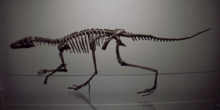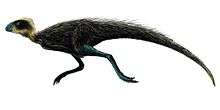Dinosauromorpha
| Dinosauromorphs Temporal range: Middle Triassic–Present, 245–0 Ma (possible Early Triassic record) | |
|---|---|
 | |
| Reconstructed skeleton of a Lagosuchus talampayensis | |
| Scientific classification | |
| Kingdom: | Animalia |
| Phylum: | Chordata |
| Class: | Reptilia |
| Clade: | Dinosauromorpha Benton, 1984 |
| Subgroups | |
Dinosauromorpha is a clade of archosaurs that includes the clade Dinosauria (dinosaurs), and other closely related animals. Birds are the only surviving dinosauromorphs.
Etymology
The name was coined by Michael J. Benton in 1984. The first clade definitions were by Paul Sereno in 1991 who defined the concept as a node clade: the last common ancestor of Lagerpeton chanarensis, Marasuchus lilloensis, Pseudolagosuchus major and the Dinosauria (including Aves) and all its descendants.[1]
Origins
Dinosauromorphs appeared by the Anisian stage of the Middle Triassic around 242 to 244 million years ago, splitting from other ornithodires. Early Triassic footprints reported in October 2010 from the Świętokrzyskie (Holy Cross) Mountains of Poland may belong to a dinosauromorph. If so, the origin of dinosauromorphs would be pushed back into the Early Olenekian, around 249 Ma. The oldest Polish footprints are from a small quadrupedal animal named Prorotodactylus, but footprints belonging to the ichnogenus Sphingopus that have been found from Early Anisian strata show that moderately large bipedal dinosauromorphs had appeared by 246 Ma. The tracks show that the dinosaur lineage appeared soon after the Permian-Triassic extinction event. Their age suggests that the rise of dinosaurs was slow and drawn out across much of the Triassic.[2]
Basal forms include Saltopus,[3] Marasuchus, the perhaps identical Lagosuchus, the lagerpetonids Lagerpeton from the Ladinian of Argentina and Dromomeron from the Norian of Arizona, New Mexico, and Texas (all in the United States), and the silesaurids, which include Silesaurus from the Carnian of Poland, Eucoelophysis from the Carnian-Norian of New Mexico, Lewisuchus and the perhaps identical Pseudolagosuchus from the Ladinian of Argentina,[4][5] Sacisaurus from the Norian of Brazil,[6] Technosaurus from the Carnian of Texas,[7] Asilisaurus from the Anisian of Tanzania,[8] and Diodorus from the Carnian(?) to Norian of Morocco.[9]
Phylogeny
Cladogram simplified after Nesbitt (2011):
| |
| |||||||||||||||||||||||||||||||||
| |
References
- ↑ Langer, M. C.; Nesbitt, S. J.; Bittencourt, J. S.; Irmis, R. B. (2013). "Non-dinosaurian Dinosauromorpha". Geological Society, London, Special Publications. doi:10.1144/SP379.9.
- ↑ Brusatte, S.L.; Niedźwiedzki, G.; Butler, R.J. (2010). "Footprints pull origin and diversification of dinosaur stem lineage deep into Early Triassic". Proceedings of the Royal Society B. 278 (1708): 1107–1113. doi:10.1098/rspb.2010.1746. PMC 3049033
 . PMID 20926435.
. PMID 20926435. - ↑ Saltopus, a dinosauriform from the Upper Triassic of Scotland. Michael J. Benton and Alick D. Walker. Earth and Environmental Science Transactions of the Royal Society of Edinburgh / Volume 101 / Special Issue 3-4, pp 285 - 299 Royal Society of Edinburgh 2011 Published online: 17 May 2011 doi:10.1017/S1755691011020081
- ↑ Irmis, Randall B.; Nesbitt, Sterling J.; Padian, Kevin; Smith, Nathan D.; Turner, Alan H.; Woody, Daniel; Downs, Alex (2007). "A Late Triassic dinosauromorph assemblage from New Mexico and the rise of dinosaurs". Science. 317 (5836): 358–361. doi:10.1126/science.1143325. PMID 17641198.
- ↑ Nesbitt, Sterling J.; Irmis, Randall B.; Parker, William G.; Smith, Nathan D.; Turner, Alan H.; Rowe, Timothy (2009). "Hindlimb osteology and distribution of basal dinosauromorphs from the Late Triassic of North America". Journal of Vertebrate Paleontology. 29 (2): 498–516. doi:10.1671/039.029.0218.
- ↑ Ferigolo, J.; Langer, M.C. (2006). "A Late Triassic dinosauriform from south Brazil and the origin of the ornithischian predentary bone". Historical Biology. 19 (1): 1–11. doi:10.1080/08912960600845767.
- ↑ Nesbitt, Sterling J.; Irmis, Randall B.; Parker, William G. (2007). "A critical re-evaluation of the Late Triassic dinosaur taxa of North America". Journal of Systematic Palaeontology. 5 (2): 209–243. doi:10.1017/S1477201907002040.
- ↑ Nesbitt, S.J.; Sidor, C.A.; Irmis, R.B.; Angielczyk, K.D.; Smith, R.M.H.; Tsuji, L.M.A. (2010). "Ecologically distinct dinosaurian sister group shows early diversification of Ornithodira". Nature. 464 (7285): 95–98. doi:10.1038/nature08718. PMID 20203608.
- ↑ Christian F. Kammerer, Sterling J. Nesbitt, and Neil H. Shubin (2011) The first basal dinosauriform (Silesauridae) from the Late Triassic of Morocco. Acta Palaeontologica Polonica (in press) doi:10.4202/app.2011.0015
External links
- Dinosaurs' slow rise to dominance 19 July 2007, BBC News, accessed July 2007



